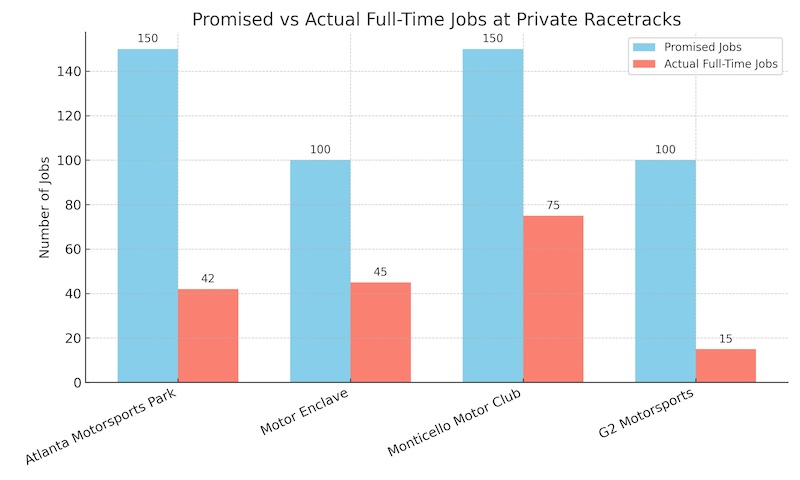
Comparing Developer Projections with Documented Outcomes at Private Racetrack Clubs
Developers of the proposed Tilke-designed Emerald Coast Motor Club (ECMC) in DeFuniak Springs have promoted the project with projections of job creation, community-friendly noise management, and economic growth through property taxes and local business activity.
To help Walton County residents evaluate these projections, we looked at documented outcomes from similar private racetrack clubs across the United States, including several Tilke “Club of Clubs” facilities (all but the California-based club). Public records and industry reports show that while these projects often promise major benefits, real-world results are more modest and sometimes bring trade-offs.
1. Job Creation: Projections vs. Reality
Employment is often a major selling point for private racetrack clubs, but data from other Florida motorsports clubs and national facilities shows a pattern of lower-than-expected local job creation:
Atlanta Motorsports Park (Georgia) – Projected 150 permanent jobs. By 2022, public records show roughly 42 full-time employees, primarily in maintenance and hospitality. Many specialized roles were filled by visiting race teams rather than local hires.
Source: Atlanta Journal-Constitution, March 19, 2022The Motor Enclave (Florida) – Employment records indicate fewer than 50 full-time staff, with about 70% commuting from the Tampa metro area. High-skill positions are typically event-based or contracted.
Sources: LinkedIn; Tampa Bay Business Journal, Sept. 2023Monticello Motor Club (New York) – Tax filings indicate roughly 50–200 total staff, with full-time employees likely under 100 and an average wage of $52,000, below the county’s tech-sector average.
Source: IRS Form 990 filings
Key Observation: At similar Tilke-designed private racetrack clubs, high-skill positions are often filled by specialists from outside the local area, leaving fewer meaningful long-term jobs for nearby residents.
2. Noise Mitigation: Documented Community and Industrial Impacts
Developers of the proposed DeFuniak racetrack emphasize noise management, but documented outcomes at other clubs show recurring community and industrial concerns:
Monticello Motor Club (NY) – Independent noise studies recorded 65–72 dB in nearby industrial zones, exceeding “quiet industry” thresholds. Several tech firms cited the racetrack noise in decisions to withdraw from a local industrial park.
Sources: Sullivan County IDA; Times Herald-Record, June 15, 2021The Motor Enclave (FL) – Noise complaints increased 300% in the surrounding area after opening. Local manufacturers reported vibration and acoustic interference from the race track affecting sensitive equipment.
Sources: Hillsborough County Noise Logs, 2023; Tampa Bay Business JournalThermal Club (CA) – Industrial tenants declined to expand, citing challenges with precision work due to persistent ambient noise from the racetrack.
Source: The Desert Sun, March 15, 2022
Key Observation: Even with mitigation efforts, noise impacts often extend beyond the racetrack club’s property lines, affecting both residential and industrial neighbors.
3. Economic Impact: Balancing Tax Revenue with Local Effects
Developers often cite property tax revenue and local business activity as reasons to approve a private racetrack club, but real-world data shows trade-offs:
G2 Motorsports (Texas) – While the club pays about $190,000 annually in property taxes, nearby agricultural land lost $1.2 million in value between 2019–2023.
Source: Fayette County Appraisal DistrictAtlanta Motorsports Park (GA) – Residential parcels within 3 miles showed 0% growth (2015–2023) versus 25% county-wide growth. Industrial parks near the track attracted no new tenants.
Sources: Dawson County Tax Assessor, 2023; Georgia Dept. of Economic DevelopmentThermal Club (CA) – Despite county-wide industrial growth, no new manufacturing tenants have leased space in the adjacent industrial park since 2017.
Source: Riverside County EDA Annual Report
Key Observation: Tax revenue gains may be offset by property devaluation and lost industrial or residential growth, particularly when noise discourages nearby development.
4. Considerations for Walton County
Experience from other private racetrack clubs and Florida motorsports facilities highlights the need for independent verification before approving the Emerald Coast Motor Club in DeFuniak Springs:
Employment projections may be optimistic, and high-paying positions are often filled by non-local specialists.
Noise management requires careful oversight, as impacts can extend to nearby neighborhoods and Woodlawn Industrial Park.
Economic benefits may come with trade-offs, including slower property appreciation and reduced industrial interest.
Bottom Line: While the proposed DeFuniak racetrack is marketed as a local economic driver, documented outcomes from Tilke “Club of Clubs” racetrack projects show that projections for jobs, noise, and tax benefits often differ from reality. Independent review is essential to ensure Walton County’s long-term interests are protected.
Verified Sources for This Report
All observations are supported by public records, tax filings, and independent media reports, including:
Atlanta Journal-Constitution; Dawson County Tax Assessor; Georgia Dept. of Economic Development; Fayette County Appraisal District; Hillsborough County Noise Logs; Tampa Bay Business Journal; LinkedIn; Riverside County EDA; Times Herald-Record; IRS Form 990; The Desert Sun.
Disclaimer:
This article is intended for informational purposes only. All comparisons and references are based on publicly available data, official reports, and independent media sources from similar motorsports developments. No statements herein are meant to assert wrongdoing, misrepresentation, or future outcomes by the developers of the proposed Emerald Coast Motor Club. Readers are encouraged to evaluate all available information and reach their own conclusions.
